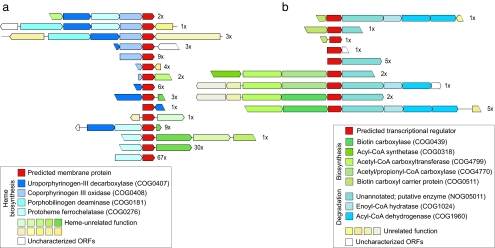Fig. 3.
Prediction of function in previously uncharacterized gene families by using genomic neighborhood. Whereas homology-based approaches quantify the known functions, neighborhood approaches reveal functional novelty, even in conjunction with well known processes. (a) A putative transmembrane protein belonging to an uncharacterized COG (COG1981 shown in red) that consistently cooccurs with members of the well characterized heme biosynthesis pathway (colored blue). The putative membrane-associated protein occurs on 174 distinct contigs in the surface sea water and whale fall data sets that can be grouped into at least 15 unique operon arrangements, strongly suggesting a role in this process. (b) A predicted putative regulator, shown in red, that links fatty acid biosynthesis (upstream, colored green) with fatty acid degradation (downstream, colored blue), a functional link not seen in fully sequenced genomes. The regulator appears on 20 distinct contigs in the sea water, of which there are at least five unique operon arrangements.

